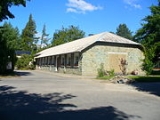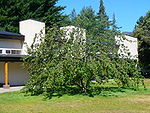
Instituto Balseiro
Encyclopedia
Balseiro Institute is an academic institution chartered by the National University of Cuyo and the National Atomic Energy Commission
. It is located in Bariloche, Río Negro province
, Argentina
.

 The Balseiro Institute teaches Physics
The Balseiro Institute teaches Physics
, Nuclear Engineering
and Mechanical Engineering
at an undergraduate level, and Physics
, Nuclear Engineering
and Medical Physics
at a graduate and post-graduate levels.
The center was established as the Instituto de Física de Bariloche on April 22, 1955, as a joint project of the National Atomic Energy Commission
and the National University of Cuyo
; the former administers the Bariloche Atomic Centre
, whose work led to the first research reactor
in Latin America (1957), as well as the region's first commercial reactor
, Atucha I
, in 1974. The institute was renamed in honor of physicist Dr. José Antonio Balseiro
in 1962. The institute admits students who have completed two years of university studies (either in Physics or Engineering) and undergo a rigorous admission procedure.
The first graduates were members of the Physics class of 1958. In the 1970s, Balseiro became the only institute in Argentina to grant degrees in Nuclear Engineering, as the country was stepping up its nuclear program with the incorporation of the Embalse
and Atucha II
, as well as continued research activity in the Constituyentes and Bariloche reactors. It's considered the best Experimental Physics and Nuclear Engineering study centres of Latin America, as well as a very prestigious one worldwide.
National Atomic Energy Commission
The National Atomic Energy Commission is the Argentine government agency in charge of nuclear energy research and development.The agency was created on May 31, 1950 with the mission of developing and controlling nuclear energy for peaceful purposes in the country.CNEA's facilities include the...
. It is located in Bariloche, Río Negro province
Río Negro Province
Río Negro is a province of Argentina, located at the northern edge of Patagonia. Neighboring provinces are from the south clockwise Chubut, Neuquén, Mendoza, La Pampa and Buenos Aires. To the east lies the Atlantic Ocean.Its capital is Viedma...
, Argentina
Argentina
Argentina , officially the Argentine Republic , is the second largest country in South America by land area, after Brazil. It is constituted as a federation of 23 provinces and an autonomous city, Buenos Aires...
.
Overview


Physics
Physics is a natural science that involves the study of matter and its motion through spacetime, along with related concepts such as energy and force. More broadly, it is the general analysis of nature, conducted in order to understand how the universe behaves.Physics is one of the oldest academic...
, Nuclear Engineering
Nuclear engineering
Nuclear engineering is the branch of engineering concerned with the application of the breakdown as well as the fusion of atomic nuclei and/or the application of other sub-atomic physics, based on the principles of nuclear physics...
and Mechanical Engineering
Mechanical engineering
Mechanical engineering is a discipline of engineering that applies the principles of physics and materials science for analysis, design, manufacturing, and maintenance of mechanical systems. It is the branch of engineering that involves the production and usage of heat and mechanical power for the...
at an undergraduate level, and Physics
Physics
Physics is a natural science that involves the study of matter and its motion through spacetime, along with related concepts such as energy and force. More broadly, it is the general analysis of nature, conducted in order to understand how the universe behaves.Physics is one of the oldest academic...
, Nuclear Engineering
Nuclear engineering
Nuclear engineering is the branch of engineering concerned with the application of the breakdown as well as the fusion of atomic nuclei and/or the application of other sub-atomic physics, based on the principles of nuclear physics...
and Medical Physics
Medical physics
Medical physics is the application of physics to medicine. It generally concerns physics as applied to medical imaging and radiotherapy, although a medical physicist may also work in many other areas of healthcare...
at a graduate and post-graduate levels.
The center was established as the Instituto de Física de Bariloche on April 22, 1955, as a joint project of the National Atomic Energy Commission
National Atomic Energy Commission
The National Atomic Energy Commission is the Argentine government agency in charge of nuclear energy research and development.The agency was created on May 31, 1950 with the mission of developing and controlling nuclear energy for peaceful purposes in the country.CNEA's facilities include the...
and the National University of Cuyo
National University of Cuyo
The National University of Cuyo is the largest center of higher education in the province of Mendoza, Argentina....
; the former administers the Bariloche Atomic Centre
Bariloche Atomic Centre
thumb|300px|View of the nucleus of the reactor RA-6. The blue light derives from the [[Cherenkov radiation|Cerenkov effect]].The Bariloche Atomic Centre is one of the research and development centres of the Argentine National Atomic Energy Commission...
, whose work led to the first research reactor
Research reactor
Research reactors are nuclear reactors that serve primarily as a neutron source. They are also called non-power reactors, in contrast to power reactors that are used for electricity production, heat generation, or maritime propulsion.-Purpose:...
in Latin America (1957), as well as the region's first commercial reactor
Generation II reactor
A generation II reactor is a design classification for a nuclear reactor, and refers to the class of commercial reactors built up to the end of the 1990s...
, Atucha I
Atucha I nuclear power plant
Atucha I is one of two operational nuclear power plants of Argentina. It is located in the town of Lima, Zárate, Buenos Aires, about from Buenos Aires, on the right-hand shore of the Paraná de las Palmas River....
, in 1974. The institute was renamed in honor of physicist Dr. José Antonio Balseiro
José Antonio Balseiro
José Antonio Balseiro was an Argentine physicist.Balseiro studied at the Universidad Nacional de Córdoba in his home city, before moving to La Plata to study and research, obtaining a doctorate in physics at the Universidad Nacional de La Plata. His doctoral dissertation was directed by Dr...
in 1962. The institute admits students who have completed two years of university studies (either in Physics or Engineering) and undergo a rigorous admission procedure.
The first graduates were members of the Physics class of 1958. In the 1970s, Balseiro became the only institute in Argentina to grant degrees in Nuclear Engineering, as the country was stepping up its nuclear program with the incorporation of the Embalse
Embalse nuclear power plant
The Embalse Nuclear Power Station is one of the two operational nuclear power plants in Argentina. It is located on the southern shore of a reservoir on the Río Tercero, near the city of Embalse, Córdoba, 110 km south-southwest of Córdoba City....
and Atucha II
Atucha II nuclear power plant
Atucha II is a nuclear power plant in Argentina, located in Lima, Buenos Aires, on a site next to Atucha I. Its construction started in June 1981 under a contract with Siemens, but it has not been finished . Like Atucha I, it is a Pressurised Heavy Water Reactor , but was planned to have a much...
, as well as continued research activity in the Constituyentes and Bariloche reactors. It's considered the best Experimental Physics and Nuclear Engineering study centres of Latin America, as well as a very prestigious one worldwide.

